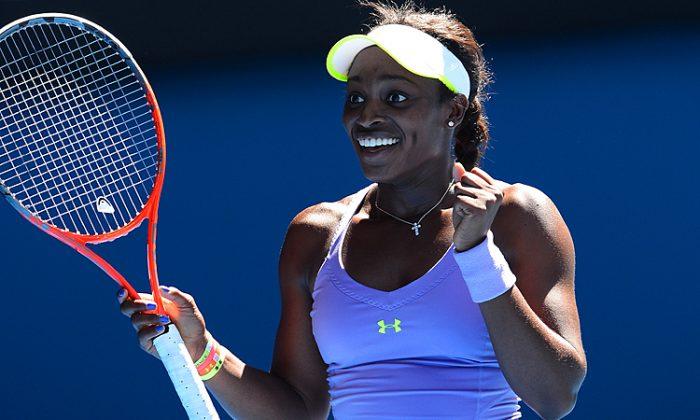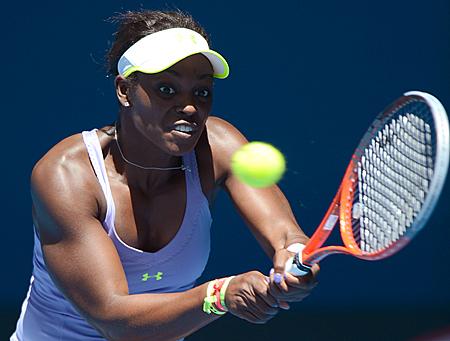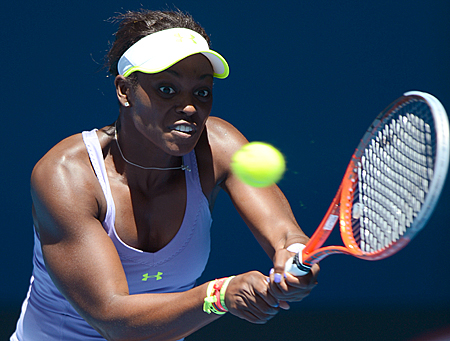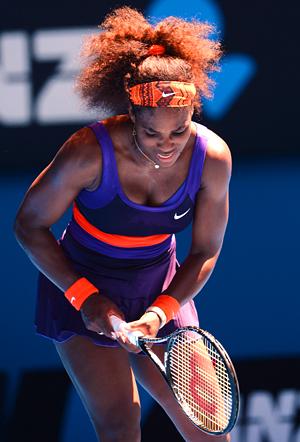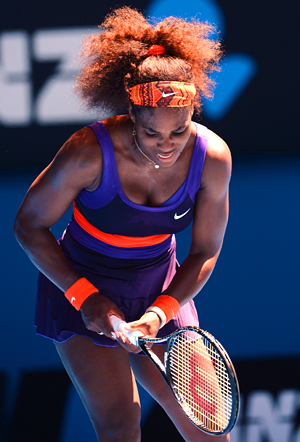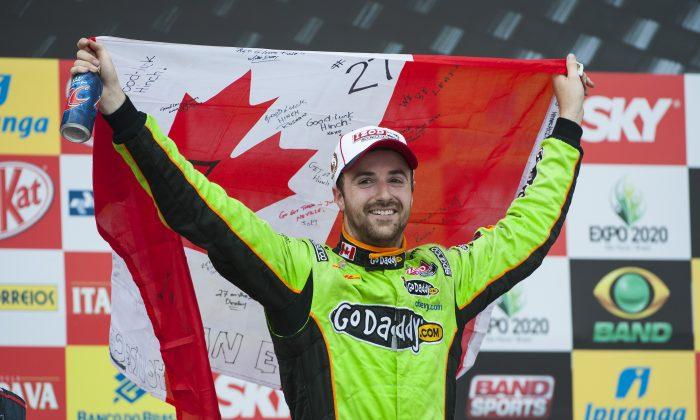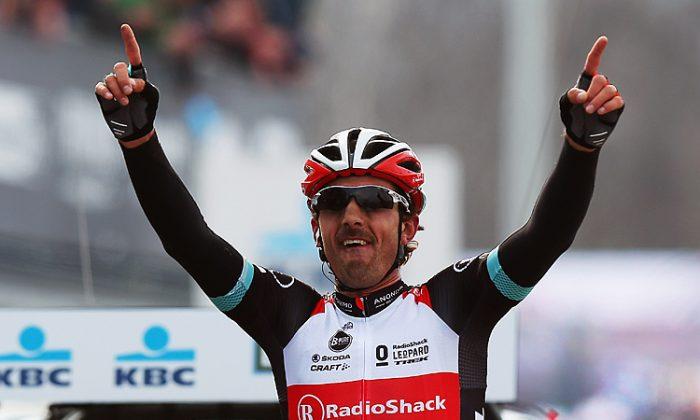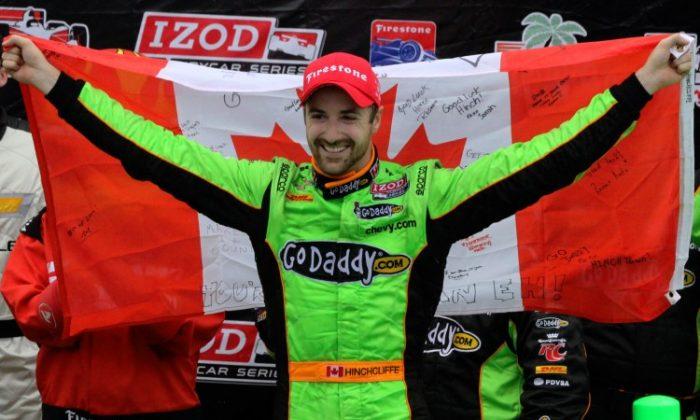America’s women’s tennis future met America’s women’s tennis powerhouse Tuesday in an Australian open quarter-final match; unfortunately, injury won out over skill.
Nineteen-year-old Sloane Stephens became the only younger American player to beat Serena Williams as the teen won a three-set match which saw Williams, already hindered by an ankle injured in her-first-round match, aggravated a back strain which silenced her explosive serve and hampered her movement, especially to the backhand.
Stephens, who had never reached a Grand Slam quarterfinal, moves on to face top-ranked Victoria Azarenka in the semis.
After the match, Stephens was asked by ESPN how she came back from a set and two games down.
“I came to play,” was her response. “I was thinking to myself, ‘Things happen in a tennis match; you got down an early break, just keep fighting.’ I’m not playing a robot, so I can get some chances, I'll have times to break and things like that. I just decided I was going to fight and do whatever I could and it worked out well.”
Stephens was asked when she knew Williams was hurt, and how it affected her.
“I heard her make a noise; I was like, ‘Uh, oh, I don’t know what that is,’ but when she called the trainer, I was like, ‘Oh, there might be a little problem,’ but I just kept playing and didn’t let it bother me really.”
Stephens was asked how should we go from the biggest win of her career Tuesday to playing the biggest match of her career—her first Grand Slam semi-final—the next day. Her response showed her a lot about her character.
“Do the same thing I’ve been doing, go to the same restaurants I’ve been going to, and just enjoy myself. And have fun. It’s the semis of a major—you just go out and do your thing and have fun.”
Her response to how she planned to play Victoria Azarenka was in the same vein:
“Just play my game and stay focused and just love being out here it’s going to be tough, yeah, I’m playing the world number one but you just gotta go out and do your thing and hopefully I'll come out with another win.”
The best part of all this is she has serious talent backing up her carefree attitude. Sloane Stephens, however far she gets at the Australian Open, is a big part of the future of American women’s tennis.
Thwarted by Injury
At 31, Williams has had her share of surgeries and injury layoffs, a few long ones for knee surgery and then her lost year where a gashed foot followed by blood clots left not only her career but her life in danger.
Upon recovering from blood clots, Williams attacked tennis with renewed vigor; nearly losing the focus of her life showed her how much the sport meant to her.
Williams won Wimbledon and the U.S. open as well as the Olympic gold, plus four other titles in 2012. After seeing her form in Australia, even after the ankle injury, people were talking about her taking all four Grand Slam titles in a row.
That talk came to an abrupt end halfway through the second set when Williams charged the net to field a drop shot a pulled up short, shouting in pain. After the game Williams went to the locker room for treatment; she returned to finish the match, but she wasn’t the same player who had won the first set 6–3 and was even in the second.
Williams’ most dangerous weapon, her howitzer serve, lost a third of its power. With every serve a weak second serve, Serena had to play more rallies, which meant more movement and even more pain, more errors, and finally, defeat at the hands of her young friend.
Let it be clear—even though Stephens folded after being broken in the first set and showed a bad tendency to tighten up and spray shots at important moments throughout the match, the talented teen very much deserved to be on the court.
Stephens lost he focus after being broken halfway through the first set, but regained her composure and was playing Williams even until her injury in the second set. Steven played amazing defense, covering the court quickly and hitting powerful ground strokes.
She missed a lot of shots—five double faults and 39 unforced errors—and most of them came at key moments when she was trying to close out a game or set. Still, Stephens did win two sets from the most powerful female player on the tour.
Just knowing that she refocused and played Serena game-for-game in the second set (until the injury) shows how talented Stephens really is. Williams wasn’t at 100 percent, but she was still serving at 119 mph before she got hurt—and Stephens won six games against her. Had there been no injury Williams would likely have won, but it certainly wouldn’t have been easy.
A word for the courage showed by Serena Williams: In her post-game press conference on ESPN Williams admitted that this had been the worst two weeks of a Grand Slam in her career.
“Kind of a tough two weeks,” she said. “Between my ankle, which was this big every day [making a basketball-sized circle], and my back which started hurting, and the loss it was … for a Grand Slam, the worst two weeks absolutely—I’m almost relieved that it’s over. There was only so much I felt like I could do.”
Her back had been hurting for a few days, she revealed. “A few days ago it just got really tight and I had no rotation on it. I went for this drop shot in the second set and it just locked up on me. I couldn’t really rotate after that.
“It was a little painful but I mean, it’s okay. It was what it was. It was giving me trouble but it was fine. I think my opponent played really well and did a really good job.
“Everyone at this stage in the locker room has something wrong with them. It’s no excuse,” she said.
During the match, her face showed how hard she was struggling to master both the pain and the frustration of not playing well. For a perfectionist like Serena, the latter was probably harder. She did break down late in the match, slamming her racket twice on the court; but she never gave up.
Asked if she ever thought of retiring, Serena responded, “Are you kidding me?” Then she realized the reporter meant, retiring from the match after her injury. “Oh I thought you meant my career; I thought, ‘You’re crazy!’”
Serena Williams has no plan to end her career. She still wants to win fifty tournaments, and probably after she has done that she will find further goals.
Someday Serena Williams will face Sloane Stephens, or someone like her, and will play her best and lose. It happens to every champion; the next generation supplants them. For Serena, it will be a while yet before that day.
The Epoch Times publishes in 35 countries and in 21 languages. Subscribe to our e-newsletter.
